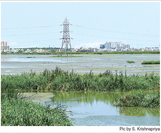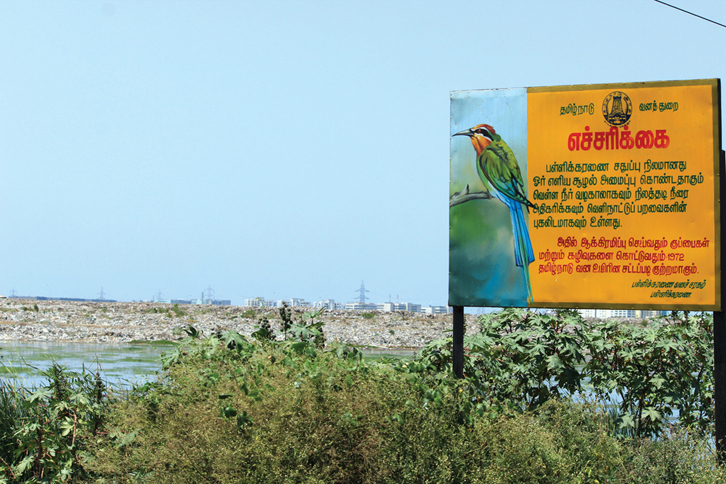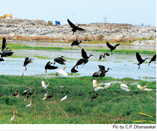|
Wetlands are shallow aquatic ecosystems found throughout the world. All wetlands are subjected to seasonal changes in depth and water chemistry; as a result, the plants and animals associated with wetlands also change with the seasons.

The Marsh today – and construction that edges it.
Pallikarnai Marsh is a wetland in South Chennai. It is one of the few remaining natural waterlands in Southern India. Although coastal in orientation, Pallikarnai Marsh is not entirely saltwater. Half of the marsh may be saline in character while the other half is fresh.
The salt-freshwater balance is very dynamic, changing rapidly with the seasons. While it tends to be a predominantly freshwater marsh during and immediately after the monsoon rains, it tends to become saline as the summer progresses.
When the existence of this extensive wetland was first brought to the notice of the public in 2002 by Care Earth, it was not known as Pallikarnai Marsh. To some, it was known as ‘Velachery marshes’ and other locally called it ‘Kazhuveli’. Care Earth christened it the Pallikarnai Marsh based on its location in close proximity to the Pallikarnai village.

A sign of protection.
After its discovery in 2002, Care Earth, with the support of the Tamil Nadu Pollution Control Board, initiated the first scientific study of the Pallikarnai Marsh. The first discovery, although discouraging, was that the nearly 600 ha of marsh that was extant in 2002 was just 10 per cent of its original extent. The discovery was more startling when it was learnt that the 90 per cent shrinking that the marsh experienced was in the past 30 years. Unplanned development in South Chennai, encroachment, and unscientific solid waste disposal were the three important reasons for the shrinking of the once extensive wetland.
The shrinking was accompanied by significant changes in hydrology in that the many channels that brought in the stormwater were blocked. The channels that drained the marsh into the Arabian Sea were also blocked, leaving Okkiyam Madavu as the sole lifeline that linked the marsh with the sea.
The marsh that was once a continuous habitat was fragmented by roads and railways resulting in major changes in the depth of the marsh. Fragmentation led to permanent changes in the water-holding capacity of the marsh. While some parts of the marsh went permanently underwater, others that were exposed dried up during summer. Areas that dried up during summer were soon invaded by the non-native ‘veli-kaathan’ tree and invasive wetland plants, changing the character of the wetland from a marsh to a swamp.
Despite fragmentation and the resultant changes in the character of the wetland, Pallikarnai Marsh continues to play a major role as an ecological service provider to South Chennai and its residents. The major ecological services provided by the Pallikarnai Marsh include mitigation of floods, regulation of local temperature and sheltering valuable biodiversity.
* * *
The total assembly of micro-organisms, plants and animals in any habitat is considered its biodiversity. The biodiversity of Pallikarnai Marsh is not yet fully documented. What is known at present is just the number of species in selected groups of plants and animals.

There's bird life again.
Of that which is known, birds are the most diverse class of organisms. Around 140 species of birds use the wetlands as their habitat and of them nearly half may be migratory. Migratory birds visit the Pallikarnai Marsh from parts of North India and beyond, coming from even the temperate regions of Eurasia, some travelling as much as 6000 km. These migratory birds spend the winter months in the marsh and fly back to their northern summer habitats to breed.
Some of the common birds that visit the Pallikarnai Marsh in winter are ducks such as the Northern Pintail, Northern Shoveller and Garganey. There are other aquatic birds called waders that visit the marsh in large numbers during winters. Waders are aquatic birds that do not swim but wade through shallow waters as they feed on tiny aquatic animals.
Some of the common waders that spend their winter in the Pallikarnai Marsh are Little Stint, Spotted Sandpiper, Ruff, Black-tailed Godwit and Grey-headed Lapwing. There are also flocks of Greater Flamingoes that spend their winter in Marsh.
Other aquatic birds that are common in Pallikarnai Marsh are resident species, or birds that spend both winter and summer in the same habitat and also breed locally. Common residents include the Black-winged Stilt, Pheasant-tailed Jacana, Purple Swamphen and many species of herons, egrets and storks. There are cormorants and ducks, like the Spot-billed Duck which are large ducks that resemble the domestic ducks and breed in the Pallikarnai Marsh. Apart from these, there are also pelicans. The species of pelican found in the marsh is the Spot-billed Pelican, a large fish-eating bird.
Fish-eating birds are important indicators of the health of wetlands. They are like tigers in forest. Fish-eating birds are carnivores and carnivores are higher up in the food chain. Pelicans, cormorants, herons, storks and terns that are found in abundance in the Pallikarnai Marsh are all more or less entirely dependent on fish for their food. When there are groups of many different varieties of these birds around, it indicates that there are lots of fish in the wetland.
Fish breeds abundantly only when the water is clean, well-aerated and cool. Pallikarnai Marsh has numerous fish in diverse varieties. Nearly 50 species of fish have been found in the marsh. Fish are important links in the aquatic food chain. When the number and diversity of the fish declines, so will the fish-eating birds. While it is not easy to monitor the population and diversity of fish in a wetland, monitoring the fish-eating birds is easy.
Fish-eating birds are ‘flagships’ of wetlands. We need to conserve them. Birds are also attractive to watch and these attributes have made the Pallikarnai Marsh a favourite destination for bird-watchers.
* * *
Bird watching is a form of recreation. There are other means of recreation too. A clean and healthy ecosystem is aesthetic. Clean and healthy wetlands are admired for their scenic beauty. Although Pallikarnai Marsh may not in its present state provide much scenic attraction, it is possible to restore the wetland and make it attractive in the near future. When it happens, it can become Chennai’s most significant outdoor recreation site. However, a lot of effort and commitment are needed to achieve this.
The Government of Tamil Nadu has taken considerable interest in restoring Pallikarnai Marsh since it was first brought to public notice in 2002. Although the process of restoration has been slow, the efforts directed towards achieving this end have been positive.
The first and foremost step taken by the Government was to formally announce that the marsh would be a protected area. Soon after this a chunk of around 300 ha of the marsh was handed over to the Tamil Nadu Forest Department. Following this several encroachments were removed and land notified for other uses were de-notified. Over the years more chunks of the marsh were brought under protection so that at present nearly 600 ha is formally protected.
Restoration plans have been drawn up. In order to implement and monitor the restoration plans the Government has established the Pallikarnai Marshland Conservation Authority (PMCA). PMCA works closely with the Forest Department and civil society. Several initiatives have been taken to create greater conservation awareness among people. Such initiatives include activities like awareness walks, bird watching programmes, and drawing and elocution competitions for local school and college students.
Care Earth Trust has prepared the master plan for restoration. Talks are on with the Chennai Corporation for the closure of the Perungudi garbage dump yard and restoration of the marsh completely.
The Forest Department has for the sake of better administration created an exclusive Pallikaranai Range and established a local office. The office premises also maintain an interpretation centre providing valuable information on the biodiversity of the marsh to visitors. A Forest Check Post monitors the marsh and controls poaching of animals. – (Courtesy: Adyar Times)
R.J. Ranjit Daniels
Care Earth Trust, Chennai
|

